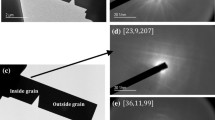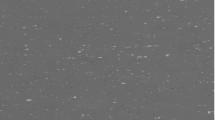Abstract
It is generally believed that, for an otherwise constant microstructure, the crack tip opening displacement at fracture(δ, IC) will scale with the primary particle spacing,X o. However, fracture toughness is also influenced by the microstructure as well as by particle spacing and volume fraction. It has been proposed that the extents of primary void growth could be used as a measure of the influence of microstructure on toughness. Two approaches to using the extents of primary void growth have been suggested. In one, it was proposed that δ,IC would scale asX o(Rv/RI), whereR v is the radius of the void as viewed normal to the fracture surface andR, is the radius of the particle nucleating the void. In the second, it has been proposed that a measure of the true local strain would be Inh/2R 1), whereh is the depth of the void, and that δIC would scale asL Inh/2R 1), whereL is some microstructural distance, taken here to beX o. These two approaches have been tested for materials for which δIC ranges from about 7 to over 150 μm. The results suggest that the two proposed scalings hold only for high-strength microstructures of low constrained ductility containing primary particles of small spacings and which blunt smoothly and not to vertices.
Similar content being viewed by others
References
J.R. Rice and M.A. Johnson: inInelastic Behavior of Solids, M.F. Kanninen, W.G. Adler, A.R. Rosenfield, and R.J. Jaffee, eds., McGraw-Hill, New York, NY, 1970, pp. 641–72.
J.R. Rice and D.M. Tracey:J. Mech. Phys. Solids, 1969, vol. 17, pp. 201–17.
J.F. Knott:Conf. Proc: Micromechanisms of Crack Extension (Mechanics and Physics of Fracture II), Cambridge, MA, 1980,in Met. Sci., 1980, vol. 14, pp. 327–36.
T.B. Cox and J.R. Low:Metall. Trans. A, 1974, vol. 5, pp. 1457–70.
J.A. Psioda: Ph.D. Thesis, Carnegie Mellon University, Pittsburgh, PA, 1977.
R.H. Van Stone, R.H. Merchant, and J.R. Low, Jr.: inFatigue and Fracture Toughness Cryogenic Behavior, C.F. Hickey, Jr. and L.G. Broadwell, eds., ASTM STP 556, ASTM, Philadelphia, PA, 1973, p. 93.
R.M. McMeeking:J. Eng. Mater. Technol., Trans. ASME, Series H, 1977, vol. 99, pp. 290–97.
R.M. McMeeking:J. Mech. Phys. Solids, 1977, vol. 25, pp. 357–81.
W.M. Grrison, Jr.:Scripta Metall., 1984, vol. 18, pp. 583–86.
A.W. Thompson and M.F. Ashby:Scripta Metall., 1984, vol. 18, pp. 127–30.
W.M. Garrison, Jr.:Metall. Trans. A, 1986, vol. 17A, pp. 669–78.
W.M. Garrison, Jr.:Scripta Metall., 1986, vol. 20, pp. 633–36.
K.J. Handerhan and W.M. Garrison, Jr.:Metall. Trans. A, 1988, vol. 19A, pp. 2989–3003.
K.J. Handerhan, W.M. Grrison, Jr., and N.R. Moody:Metall. Trans. A, 1989, vol. 20A, pp. 105–23.
K.J. Handerhan and W.M. Garrison, Jr.:Scripta Metall., 1988, vol. 22, pp. 409–12.
W.M. Grrison, Jr. and N.R. Moody:Metall. Trans. A, 1987, vol. 18A, pp. 1257–63.
K.J. Handerhan and W.M. Garrison, Jr.:Scripta Metall., 1988, vol. 22, pp. 607–10.
K.J. Handerhan: Ph.D. Thesis, Carnegie Mellon University, Pittsburgh, PA, 1988.
J.W. Bray, J.L. Maloney, K.S. Raghavan, and W.M. Garrison, Jr.:Metall. Trans. A, 1991, vol. 22A, pp. 2277–85.
CF. Shih:J. Mech. Phys. Solids, 1981, vol. 29, pp. 305–30.
M.F. Ashby and R. Ebeling:Trans. AIME, 1966, vol. 235, pp. 1396–1404.
J.E. Hilliard:Stereology: Principles and Practices, Northwestern University, Evanston, IL, 1981.
A. Boyde:J. Microsc, 1973, vol. 98, pp. 452–71.
E.H. Lee and A.J. Wang:Proc. 2nd U.S. National Congress of Applied Mechanics, ASME, New York, NY, 1954, p. 489.
F.A. McCHntock: inFracture, H. Liebowitz, ed., Academic Press, New York, NY, 1968, vol. 1, pp. 47–225.
A. Needleman and V. Tvergaard:Elastic Plastic Fracture Mechanics, STP 803,Inelastic Crack Analysis, ASTM, Philadelphia, PA, 1983, vol. 1, pp. 80–115.
C.L. Horn and R.M. McMeeking:J. Mech. Phys. Solids, 1989, vol. 37 (3), pp. 395–415.
Author information
Authors and Affiliations
Additional information
Formerly Graduate Student, Carnegie Mellon University
Formerly Graduate Student, Carnegie Mellon University
Rights and permissions
About this article
Cite this article
Bray, J.W., Handerhan, K.J., Garrison, W.M. et al. Fracture toughness and the extents of primary void growth. Metall Trans A 23, 485–496 (1992). https://doi.org/10.1007/BF02801166
Received:
Issue Date:
DOI: https://doi.org/10.1007/BF02801166




